The 2018/19 season was nearly something special for Borussia Dortmund. Despite holding a seven-point lead in the Bundesliga at one stage, they succumbed to the pressure, and Bayern Munich once again took home the Meisterschale. After missing out on what would have been their first league title for seven years, Dortmund has brushed off the disappointment and continued to build their squad this offseason. Could the new season bring silverware to the Westfalenstadion?
This scout report will look at whether they have made the right moves in the transfer market, and how their new signings can fit into the tactics employed by Head-coach Lucien Favre. It will also delve into the strengths of this Dortmund side and what improvements can be made, and there will be a tactical analysis highlighting BVB’s formation preferences.
Lucien Favre
Last season was Favre’s first year in charge at Dortmund, but the Swiss manager is no stranger to the German league. He had successful spells at Hertha BSC and Borussia Mönchengladbach, before moving to France to take over the reins at Nice.
Favre favours patient build-up play, and Borussia Dortmund’s uncanny knack of scoring late goals is down to this disciplined approach, rather than any perceived luck.
There is also an emphasis on wing-play, which saw Jadon Sancho become the breakout star of world football last year. His wingers are given license to play close to the centre-forward, allowing the wing-backs space to push on, or play wide themselves, isolate the defender, and either cross or take on the full-back. With Sancho’s pace and dribbling ability, as well as finishing instinct, this makes Dortmund very hard to defend against.
Favre has also provided plenty of opportunities for younger players. Jacob Bruun Larsen, Dan Axel-Zagadou, Abdou Diallo, and Christian Pulisic all saw significant minutes throughout last season, with the latter two players sealing big-money moves to European giants Paris Saint-Germain and Chelsea, respectively.
It appears this trend will continue in the 2019/20 season too, with Claudio Reyna’s 17-year-old son, Giovanni, attracting attention with his pre-season performances for the first team. He could be one to watch this season, as could new signing Mateu Morey, once he is back at full fitness.
Morey is one of several improvements Favre has made to the squad.
New signings
Both Julian Brandt and Thorgan Hazard have been two of the most consistently performing wingers in the Bundesliga in recent years. In his first five seasons of professional football with Bayer Leverkusen, 23-year-old Brandt has scored a total of 40 goals, and 35 assists in all competitions. Hazard has just been just as effective, and in the same time frame has scored 47 goals, and made 32 assists. Both of these players are going to come into the side and contribute straight away. They will take a lot of the creative burden off of the shoulders of 19-year-old Sancho.
Hazard may well see game time at centre-forward as well as on the wing. He had a short goal-scoring cameo as a centre-forward against Udinese last week before an injury saw his afternoon ended prematurely.
Despite the disappointment of losing Abdou Diallo after only prizing him away from Mainz 05 this time last year, they have moved swiftly to fill in the considerable gap left by the French defender. Former player and serial winner Mats Hummels has returned to the Westfalenstadion, as well as proven left-back Nico Schulz.
Dortmund fans may well take a while to warm to Hummels after he left them in 2016 to rejoin his boyhood club, and Dortmund’s biggest rival, Bayern Munich. However, he will bring much-needed experience to the side, and having won everything as a player so far in his career, Hummels will be an excellent role-model to Dortmund’s fleet of young stars. Schulz will slot into left-back seamlessly, where Diallo spent much of last season.
Schulz, on the other hand, is an attacking left-back with excellent dribbling ability. He likes to play high and get behind the opposing full-back. This is exactly the type of left-back that Favre wants in his side – a left-sided Piszczek. Defensively he is strong too, with a 56.5% defensive duel win ratio. He also makes a respectable 3.46 interceptions per game.
To top off their summer business so far, BVB signed last season’s top scorer Paco Alcacer permanently, following his loan spell.
After coming so close to a title last season, and having made these moves in the transfer window, there is naturally a lot of buzz in Dortmund going into the new season.
Tactics
We can see Dortmund favoured a 4-2-3-1 for much of last season, however, it wasn’t uncommon for them to play a 4-4-2, or a 4-1-4-1.
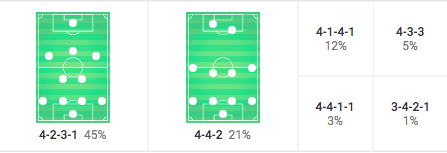
From both 4-2-3-1 and 4-4-2, they concede 1.19 goals per game, and 1.18 goals per game, respectively. Dortmund are a free-scoring team and average 2.1 goals per game in their 4-2-3-1, but a staggering 2.73 goals per game with a 4-4-2.
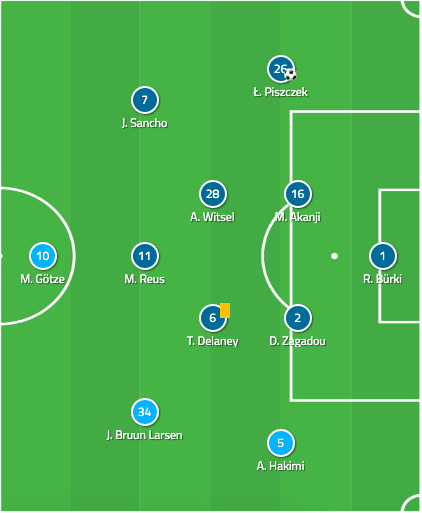
Above is Dortmund’s most used line up from last season. Schulz will compete for the left-back position, as will Hummels for a starting role at centre-back. It would be surprising, too, if Jacob Bruun Larsen can keep the likes of Julian Brandt and Thorgan Hazard out of the starting XI.
However, the position I’m most excited to see the development of is the role of the centre-forward. Borussia Dortmund weren’t short of goals last season and opted to let Alexander Isak leave for a small sum to Real Sociedad. This move was certainly surprising after Isak’s breakout season on-loan at Willem II in the Eredivisie. But Favre is clearly happy with his options up front.
Götze scored seven goals and made six assists last season, five of his goals and five of his assists coming when playing as a centre-forward. Interestingly, he started more games than top-scorer Paco Alcacer. The Spaniard scored seven of his 19 goals last season as a starter. When starting games, Alacacer scored a goal every 183 minutes. Incredibly the other 12 came as a substitute. As a substitute, Alcacer is scoring a goal every 39 minutes.
They are very different in the way they play. Götze plays as a false nine. Alcacer, on the other hand, is a complete forward. He is a threat in the air and good with both feet. Alcacer is as adept dropping deep to receive the ball, before playing the ball behind the defence, as he is playing on the last man, finding space with his impeccably timed runs. Both players are effective in their own way and it means that a 4-2-3-1 formation can have two different focuses, depending on who is playing centre-forward.
Favre will be anxious to help Alcacer be as prolific as a starter as he is as an impact sub. With Götze naturally looking to drop deep as a forward, Favre has been experimenting in pre-season with them both playing as forwards in a 4-4-2. However, as Marco Reus is most at home in a number ten role, we may only see this formation with Alcacer and Götze as forwards if Reus is absent.
Often the 4-4-2 will merge into a 4-2-3-1 with one of the forwards playing higher, and the other dropping into the ten role.
Last season Dortmund used a 4-1-4-1 at times, and the formation has reared its head once more in pre-season this summer.
It was often used in games when Dortmund either wanted to all-out attack or hold out defensively, with differing success. The 4-1-4-1 attacking and defensive formations were similar on paper, except for the two centre-midfielders. When attacking, Favre would play Götze and Reus in these roles, and defensively Dahoud and Delany. Witsel was always the defensive midfielder. We can see these formations below.
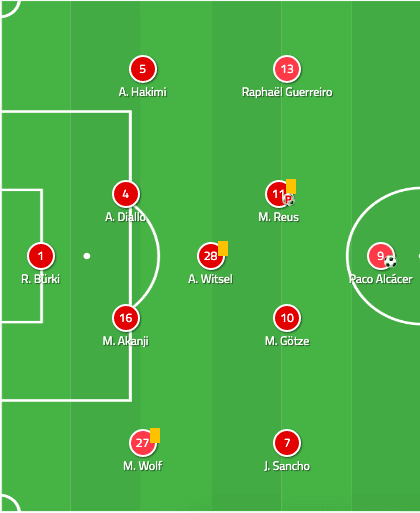
With the attacking formation, they beat Stuttgart 3-1 and lost 1-0 to Tottenham Hotspur. Dortmund are planning on using this tactic again this season. However, it is unlikely we will see its defensive equal.
It was the Champions League first leg against Spurs where Dortmund played a defensive 4-1-4-1. The system was a failure as they slid to a 3-0 loss. The only other time they used this defensive formation was in a 5-0 loss to Bayern Munich.
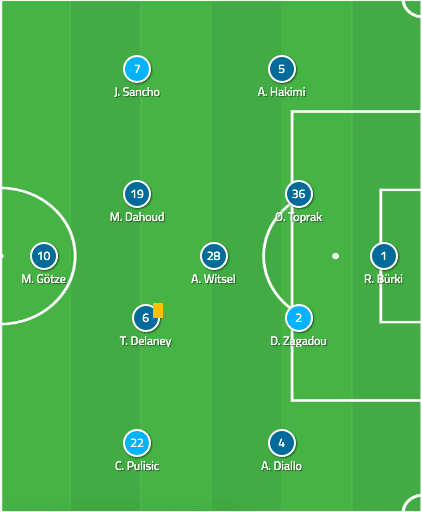
As mentioned earlier, these are the three formations that have been used in pre-season thus far. It is clear Favre isn’t changing anything drastically in regards to tactics and will be hoping that new personnel will be the difference-maker this season.
Defensive shape
It’s fair to say Favre hasn’t disregarded Klopp’s Gegenpress, however, the pressing intentions of his side are not at the same levels of intensity. They recovered the ball in high areas a respectable 12.64 times per game last season, and Favre will no doubt expect his forward players to continue to press high and win the ball in good areas. However, Favre will often have his players drop entirely into their own half, into a 4-4-2 or 4-1-4-1 formation.
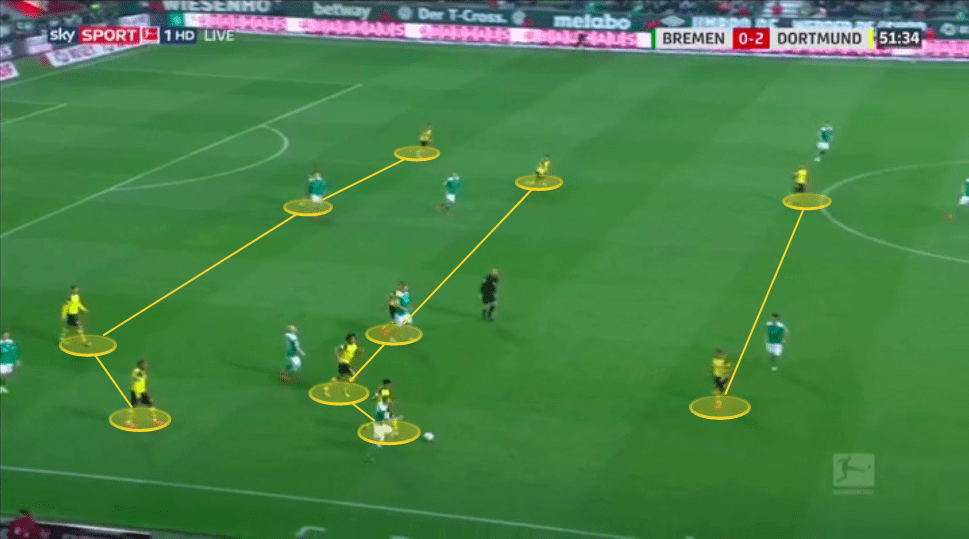
Dortmund use this system against sides that are good on the ball. Any pass backwards by the opposition is often the trigger for their press, but otherwise, they will sit patiently in their shape, and wait for an error to regain possession.
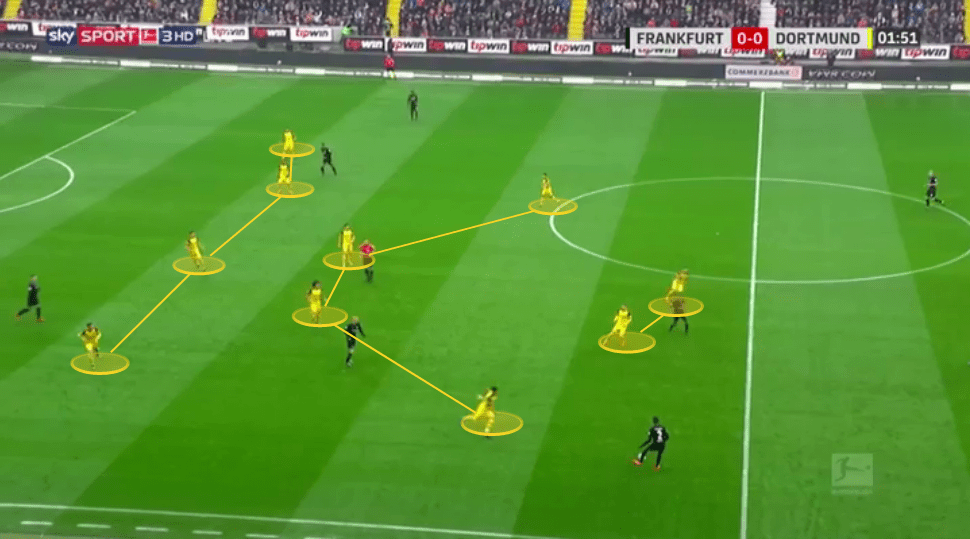
The 4-2-3-1 is used when Dortmund want to press higher. They used this formation in their pre-season game against Udinese, in which they won 4-1. In this game, they allowed only 9.89 passes per defensive action.
With the 4-4-2 system, Dortmund sit back more, allowing the opposition time to develop play. This is backed up by their 3-2 win vs Liverpool where, when playing a 4-4-2, they allowed a much higher 27.92 passes per defensive action. This is consistent with their use of this system last season too. After regaining possession against Liverpool they looked to move the ball forward as quickly as possible. Just under 8% of their passes were long balls. The 4-4-1-1 system they use is again very similar to the 4-4-2, but as mentioned earlier, even though they will sit deeper, they will still press on a backwards pass.
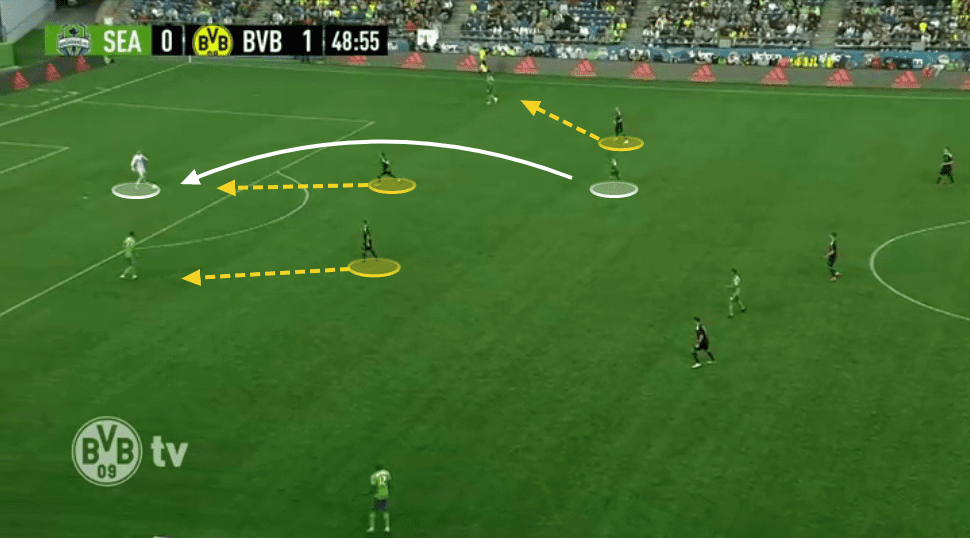
Build-up play
Favre wants his side to play out from the back, which has been very evident throughout pre-season as it was for much of last season, too.
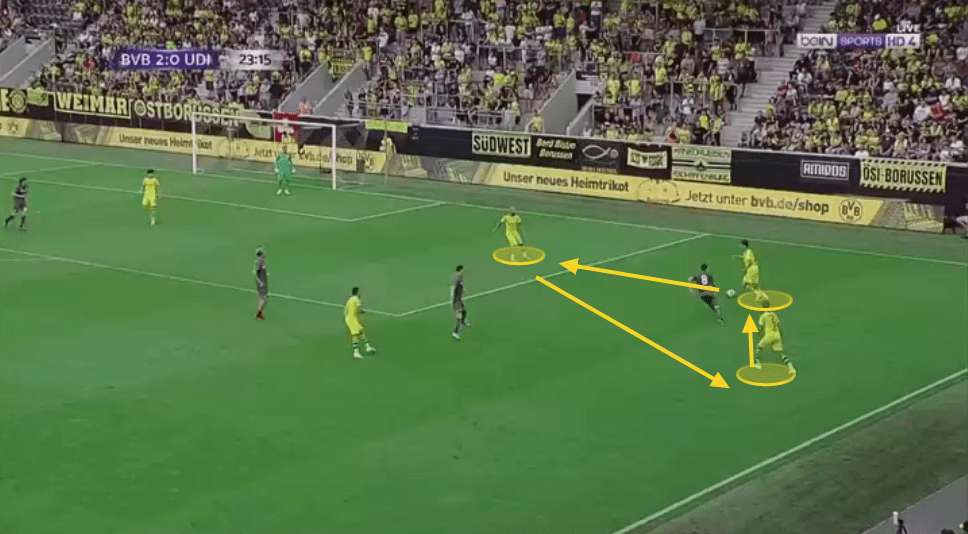
Against Udinese last week, Dortmund created several opportunities from winning the ball at the back. They frequently displayed patient build-up play, waited for the opportunity to work the ball into the wide areas, and followed by attacking in great numbers.
Their attacking intent is often signalled by their centre-backs. Once they are in possession, Dortmund will take up their formation and the centre-back in possession often looks for a quick ball into one of the wingers.
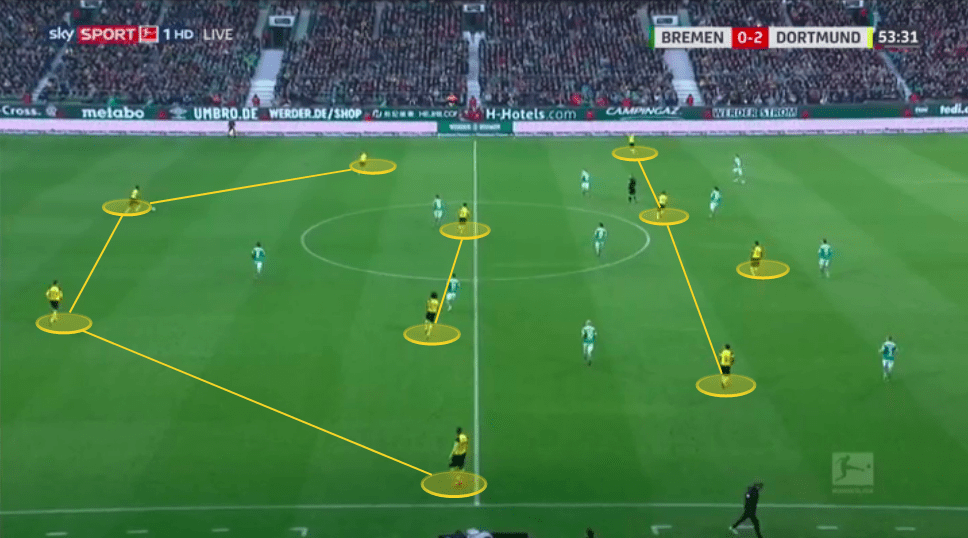
Favre wants his wingers involved as quickly as possible, whether that’s with them receiving with the ball at their feet, or with the ball played over the opposing full-back.
More often than not though, the ball will be played into Axel Witsel. Witsel is the pace-setter of the team and, as you can see from the heat map, is dominant in midfield. He is always involved whether it is attacking or defensive. His 95% pass completion rate from last season, on just under 70 passes a game, highlights how much the tempo of the side runs through him.
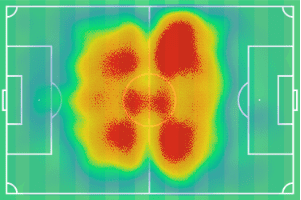
This will be no different this season. Witsel will continue to be a key member of the starting XI, and it perhaps shows that he had the joint highest appearances for Dortmund last season. Joint, of course, with Jadon Sancho.
Dangerous wingers
Dortmund scored an incredible 99 goals last season, but only 12 goals from open play had no involvement from a winger.
Although the likes of Bruun Larsen, Guerreiro, and Pulisic all featured on the wings last season, the ever-present force from wide areas was Jadon Sancho. Favre will expect Brandt and Hazard to contribute similarly, and it’s important to analyze Sancho’s movement to see how the new signings will be expected to play.
Sancho is an excellent dribbler and is at his best when running at the back four with pace and purpose. Although Bruun Larsen did an excellent job last season, both Hazard and Brandt are closer to Sancho’s creative output.
Favre will use the attacking potency of his new duo to provide greater space for Sancho, as they will garner as much attention from the opposing defence as Sancho does.
Dortmund will be able to spread defences wide and find gaps between centre-backs and full-backs. They will look to isolate their pacy wingers against full-backs where they can either cross to the numbers piling into the area or take them on in a 1v1 situation. Sancho, Hazard, and Brandt all had dribble completion rates higher than 50% last season.
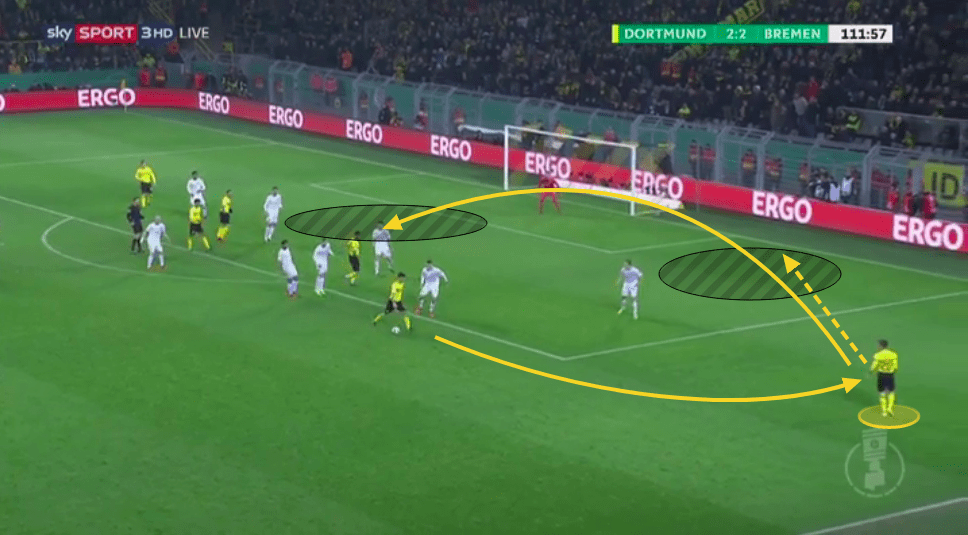
The English teenager scored 18 goals and produced 19 assists last season in all competitions and much of Dortmund’s play is based around getting him involved as often as possible. He will push high and wide, looking to receive the ball over the defender, or sit closer to the centre-forward and look for quick interchanges. However, he is mature enough to wander into deeper positions, knowing his right-back can push into the vacant space.
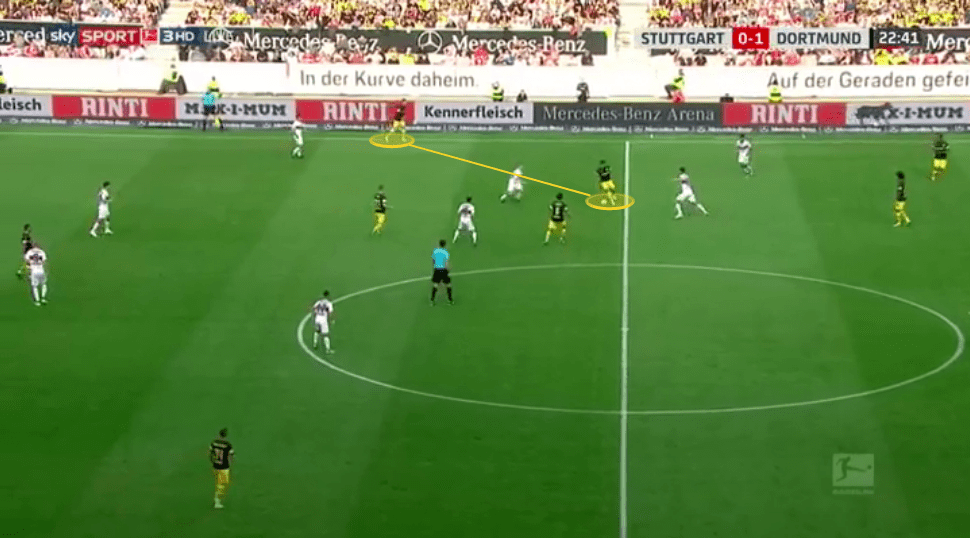
Once that right-back is in possession of the ball in an advanced area, Dortmund can attack in numbers. It is not uncommon to see six or seven Dortmund players in goalscoring opportunities when the ball is worked wide. BVB have continued to show this throughout pre-season, and Dortmund fans can expect Favre’s side to continue to attack with numbers this season.
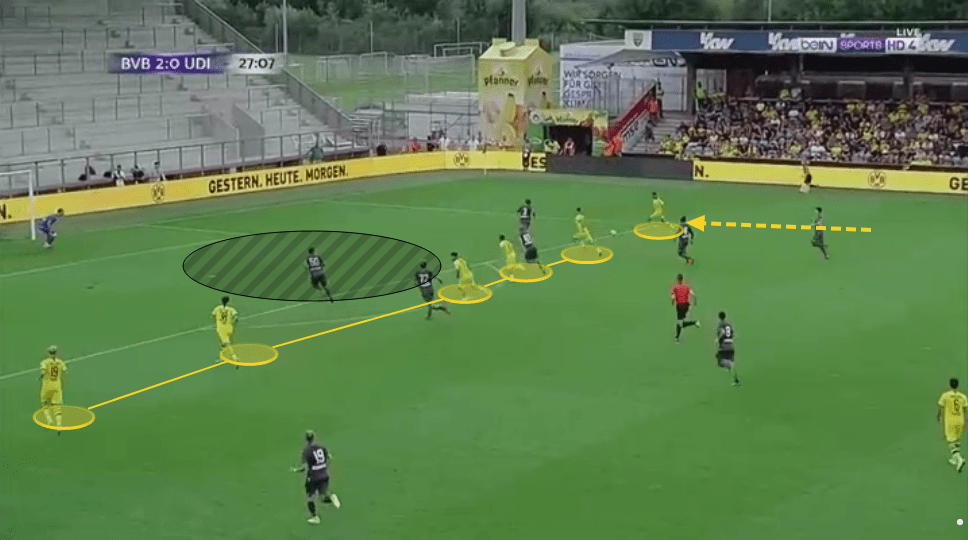
Attacking intent
Favre is keen to ensure his side overload defences with considerable numbers when attacking.
This is not just from wide positions, however. Dortmund commit numbers forward whenever they have the ball in the opposition half.
Regardless of this attacking intent, it is a credit to Favre’s defensive organization that Dortmund had the fourth-best defence in the league last year. Favre will be confident they will perform even better with Hummels and Schulz added to the backline.
In the below analysis, we can see how narrow Dortmund are in their pre-season game against Seattle Sounders. By committing numbers forward they look to occupy the back four and trust their side’s ability to play quick interchanges before making the killer pass into the smallest of spaces.
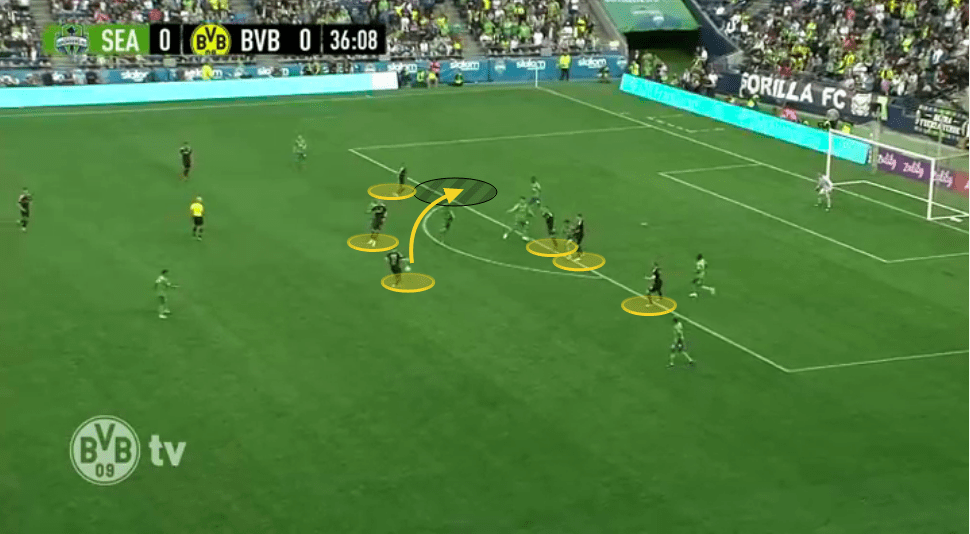
So far in pre-season Götze has featured heavily. He has played either as a CAM, or a false nine as part of a forward two. Favre is keen to pair Götze and Alcacer more often, rather than as a system where one plays at the expense of the other.
Conclusion
After coming so close last year, BVB will be confident they can go one step further this season. They have had a year to learn to play under Lucien Favre, and the side has been strengthened this summer. Jadon Sancho’s influence can’t be understated; the same can be said for Axel Witsel, Marco Reus, and Paco Alcacer. However, the throng of new arrivals this summer has the potential to take Dortmund to the top of the table once more – and stay there.
It was Dortmund’s form in the second half of the season that cost them the title. But with a much stronger squad this season, they could have the legs to finally end Bayern’s domestic dominance.
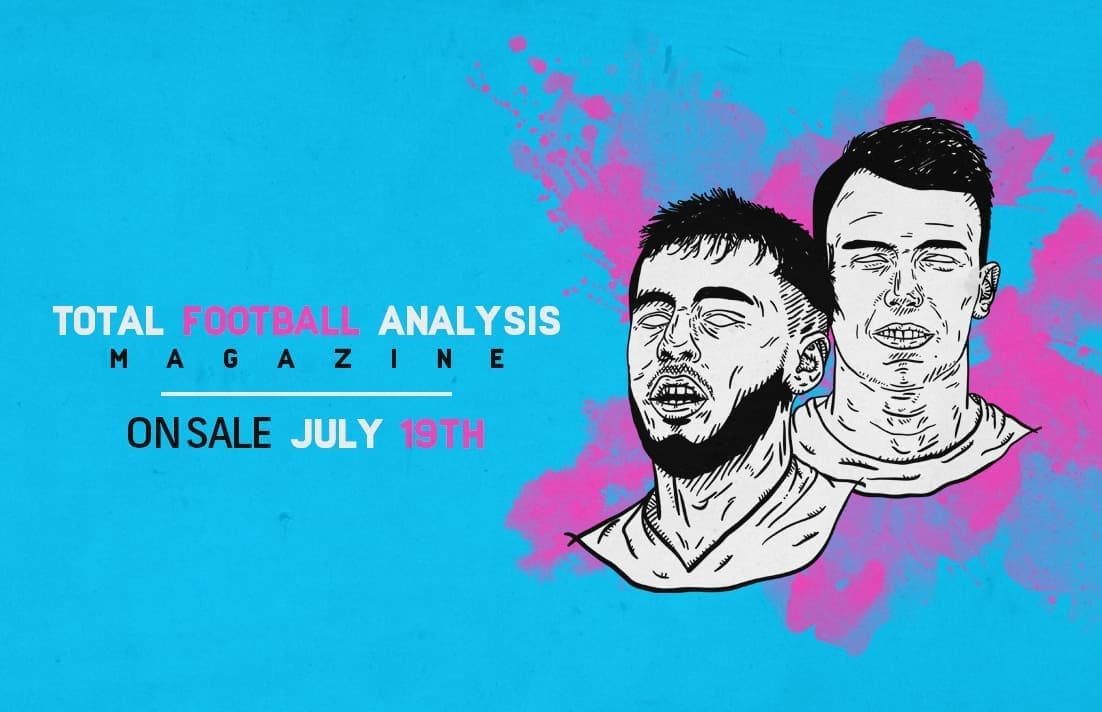
If you love tactical analysis, then you’ll love the digital magazines from totalfootballanalysis.com – a guaranteed 100+ pages of pure tactical analysis covering topics from the Premier League, Serie A, La Liga, Bundesliga and many, many more. Buy your copy of the July issue for just ₤4.99 here, or even better sign up for a ₤50 annual membership (12 monthly issues plus the annual review) right here.

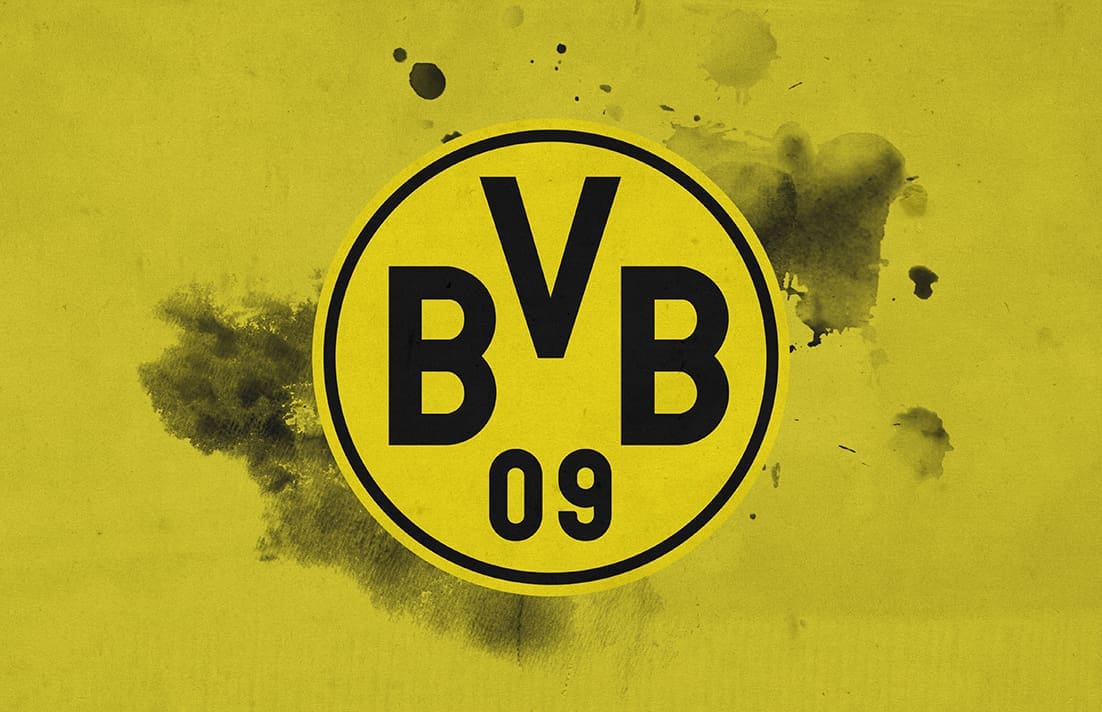


Comments